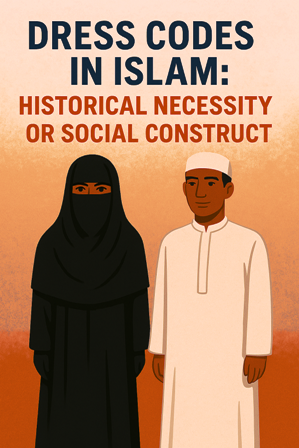From Desert Survival to Religious Doctrine: The Hidden Truth Behind Muslim Attire
Discussions surrounding women’s dress codes have been prevalent across the globe, and they are not limited to Islam. Most religions establish guidelines on attire, with varying degrees of restriction. In my previous article, “Dress Code for Women,” I explored different perspectives on this issue. Today, I turn my focus to dress codes within the Muslim community—how they evolved and their underlying logic.
The Philosophy Behind Women’s Dress Code
Women’s attire is often debated in terms of modesty versus provocation. Some argue that revealing clothing can seduce men, potentially leading to inappropriate behavior. This belief has led many in the Muslim community to consider the burqa as the best means of protecting women from unwarranted attention.
More than 80% of Muslims perceive the burqa as a safeguard for women. If this sentiment holds true for your family as well, then one must ask:
- Why do Muslim men also wear long, fully covered white garments?
- From whom do they seek protection?
- Were men ever compelled by women to adopt this attire?
These questions prompt an exploration of how clothing traditions were shaped, particularly in Arabian regions.
The Practical Origin of Men’s Traditional Dress
Imagine Arabia a few thousand years ago—before petroleum, before modern conveniences. A land dominated by vast deserts, extreme heat, and relentless sandstorms. Life was arduous, and survival demanded adaptation.
Men, responsible for gathering food and resources, ventured into the scorching deserts. To protect themselves from the relentless heat and burning sand, they covered their entire bodies with long garments.
But why white?
Science now confirms that white absorbs the least heat compared to other colors. In the absence of scientific knowledge, ancestors instinctively chose white garments to reduce heat absorption, allowing men to endure long hours under the blazing sun.
Understanding Women’s Dress Code
If men’s attire evolved for practical survival, what about women’s clothing? The long garments worn by women, now recognized as the burqa, may have originated from similar reasoning.
A question arises—why black? Wouldn’t white have been more practical?
Our ancestors, highly perceptive, distinguished men from women through color-coded clothing. With men donning white, women wore black to ensure easy differentiation, even from a distance. This distinction became culturally ingrained and later intertwined with religious traditions.
Religion and Tradition: A Combined Influence
Islam, originating in Arabia, spread globally. Over time, dress codes influenced by geographical necessity transformed into religious practices. The blending of tradition with religion solidified clothing norms that have persisted for centuries.
However, globalization altered cultural dynamics. People traveled, exchanged traditions, and adapted to diverse environments. Some embraced change; others preserved ancestral customs, passing them down through generations.
Today, a mix of Muslim attire exists—some adhere strictly to traditional clothing, while others integrate modern styles.
Reevaluating Attire Based on Environment
There is no harm in following traditions, but knowing their origins allows for informed decisions.
- A burqa may suit deserts, but does it make sense in colder regions?
- In European winters, warm clothes are essential—shouldn’t the same logic apply in hot climates like India or Pakistan?
Muslim women in extremely hot regions often wear black burqas, which absorb heat and may pose health risks. Shouldn’t environmental adaptation be considered?
Beyond Clothing: Addressing Societal Issues
If the burqa aims to protect women from potential harm caused by men’s desires, then the focus should shift to the upbringing of men.
- Tribal societies, where men and women live unclothed, report no cases of sexual violence—proving that attire is not the root issue.
- Crimes against children and elderly women occur despite their modest dressing—suggesting deeper social problems.
- Rape is not a consequence of women’s attire but rather a failure in male education and societal values.
Hinduism once practiced Sati, where widows were burned alive. Reformers like Raja Ram Mohan Roy abolished such traditions, reflecting progress and rationality.
Societies must question and refine traditions, ensuring justice and equality for all.
Conclusion
Human intelligence is remarkable—capable of uncovering the mysteries of space, oceans, and life itself. Yet, paradoxically, it remains entangled in rigid beliefs.
If traditions emerged from geographical necessity, shouldn’t people reconsider their relevance in today’s world? Living by religious principles is a choice, but individuals must be empowered with knowledge to make informed decisions about their way of life.


 Men, responsible for gathering food and resources, ventured into the scorching deserts. To protect themselves from the relentless heat and burning sand, they covered their entire bodies with long garments.
Men, responsible for gathering food and resources, ventured into the scorching deserts. To protect themselves from the relentless heat and burning sand, they covered their entire bodies with long garments.